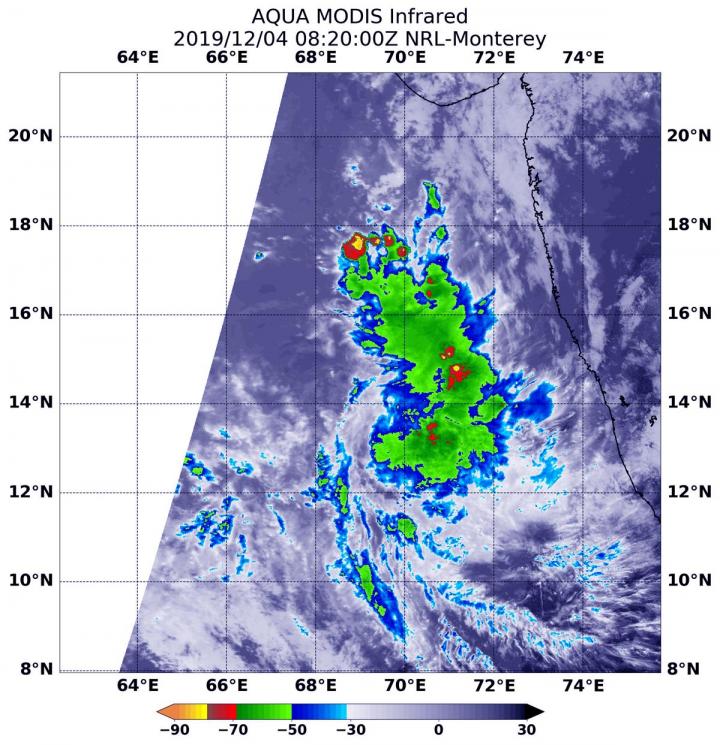
Credit: Credit: NASA/NRL
NASA’s Aqua satellite found that wind shear was tearing at Tropical Storm 07A in the Arabian Sea.
NASA’s Aqua satellite used infrared light to analyze the strength of storms in 07A. Infrared data provides temperature information, and the strongest thunderstorms that reach high into the atmosphere have the coldest cloud top temperatures. On Dec. 4 at 3:20 a.m. EST (0820 UTC), the Moderate Resolution Imaging Spectroradiometer or MODIS instrument aboard NASA’s Aqua satellite gathered temperature information about Tropical Storm 07A’s cloud tops. MODIS found three small areas of powerful thunderstorms where temperatures were as cold as or colder than minus 70 degrees Fahrenheit (minus 56.6 Celsius). Cloud top temperatures that cold indicate strong storms with the potential to generate heavy rainfall.
Cloud tops surrounding those small areas were warmer, indicating those storms were weaker. The bulk of thunderstorms in 07A were warmer than minus 70 degrees Fahrenheit and they were being pushed to the east from westerly wind shear.
In general, wind shear is a measure of how the speed and direction of winds change with altitude. Tropical cyclones are like rotating cylinders of winds. Each level needs to be stacked on top each other vertically in order for the storm to maintain strength or intensify. Wind shear occurs when winds at different levels of the atmosphere push against the rotating cylinder of winds, weakening the rotation by pushing it apart at different levels. Winds from the west were displacing the bulk of clouds and showers from 07A and pushing them to the east.
On Dec. 4 at 4 a.m., EST (0900 UTC), Tropical Storm 07A was located near latitude 14.9 degrees north and longitude 68.7 degrees east in the Arabian Sea, Northern Indian Ocean. That is about 616 nautical miles south of Karachi, Pakistan. 07A was moving to the northwest and had maximum sustained winds near 45 knots.
Tropical Storm 07A is expected to weaken to a depression by Dec. 5 and then dissipate.
Typhoons and hurricanes are the most powerful weather event on Earth. NASA’s expertise in space and scientific exploration contributes to essential services provided to the American people by other federal agencies, such as hurricane weather forecasting.
###
By Rob Gutro
NASA’s Goddard Space Flight Center
Media Contact
Rob Gutro
[email protected]
Original Source
https:/




